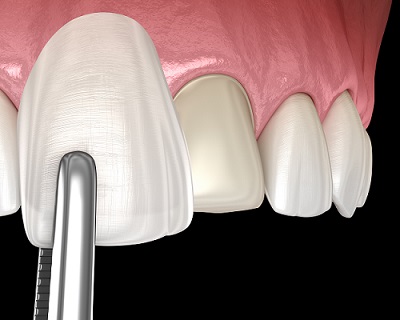Maybe Americans have been deluged with too many photoshopped Instagram influencers or retouched model photos or commercials touting the latest tooth whitening treatment. Whatever the reason, studies show that most Americans are unsatisfied with the way their smile looks.
If you want your teeth to look differently or your smile to appear brighter, you are definitely not alone. The problem is what to do next. Most people have heard of dental veneers but aren’t quite sure what they are. Others aren’t sure if cosmetic dentistry is worth their time and money. For this reason, we decided to find out everything you need to know about veneers and whether they can help you get the smile you want.
What Are Dental Veneers?
Essentially, veneers are thin, tooth-colored shells that are affixed to the front of teeth to make them look better. In addition to creating a nicer smile, they also help protect them from further damage . Typically, they are made from porcelain or resin-composite materials, which are permanently bonded to your teeth.
One benefit is that they are less invasive than a crown covering the entire tooth. Because they are attached to your natural teeth, they can be a better fix than replacing them with implants or dentures. Usually, they are applied to the top front teeth in an effort to correct broken, chipped, or discolored teeth. Often referred to as a smile makeover, they are considered a cosmetic treatment because they are elective.
What Are the Different Kinds of Veneers?
Generally, dental veneers are made with porcelain or composite resin, which require a great deal of prep work. On the other hand, some people prefer no-prep veneers, which use a different process. You can even choose removable veneers if you don’t want to make any permanent changes to your teeth at this point.
Porcelain Veneers
The most popular material for veneers, porcelain veneers are made from ceramic materials and are more stain resistant than composite ones. Dentists usually start the process by grinding down the teeth and making an impression of them in order to make a mold. The next step is to send the mold to a lab to make the porcelain veneer. As soon as the veneer is ready, your dentist can attach it to the tooth and cement it in place.
One of their big advantages is that they don’t need much preparation for successful shell placement. In contrast to more restorative procedures like crowns, porcelain veneers are minimally invasive. Each veneer is customized to the patient and made to last anywhere from 10 to 15 years.
Composite Resin Veneers
Instead of porcelain, some people choose veneers made of composite resin, which is basically the same material used for tooth-colored cavity fillings. Slightly less expensive than porcelain, they can be made quickly, and so they are usually offered as a same-day treatment option.
Like porcelain, composite veneers should have teeth recontouring prior to placement. They can, however, be placed directly on uncut enamel. One of their advantages is that, unlike porcelain, chipped areas can be replaced. Nevertheless, composite veneers only last about 5 to 7 as opposed to about 10 to 15 years for porcelain.
No-prep Veneers
You may have heard of brand names like Lumineers or Vivaneers. These are known as no-prep veneers because they are less invasive and take less time to apply. Even though they are also made from porcelain, no-prep veneers don’t require the dentist to remove any layers of the tooth under the enamel. Indeed, Lumineers are so thin that they don’t need tooth recontouring. Often, this type of veneer can be attached without a local anesthetic or temporary veneer. Moreover, they may last for as long as 20 years. Nevertheless, they tend to chip more easily than traditional veneers, which may shorten their lifespan.
Removable Veneers
For a less invasive and less costly alternative, you could opt for removable veneers. These veneers come in the form of snap-on molds that can be removed at any time. Unlike other veneers which are irreversible, removable veneers do not require any tooth reduction. On the other hand, these veneers don’t blend in as well with your regular teeth, and therefore, can be uncomfortable.
The main reason for getting veneers is to improve the look of your teeth and give you a brighter smile. For this reason, people usually get them to correct issues such as gaps in their teeth, discoloration, chipping, or staining from fluorosis or antibiotics. In essence, anyone who is unsatisfied with their smile would be a strong candidate for veneers. Because getting veneers is a customized process, it is important to work with a knowledgeable cosmetic dentist who knows your teeth and what would work best to give you the smile you’ve been longing for.




